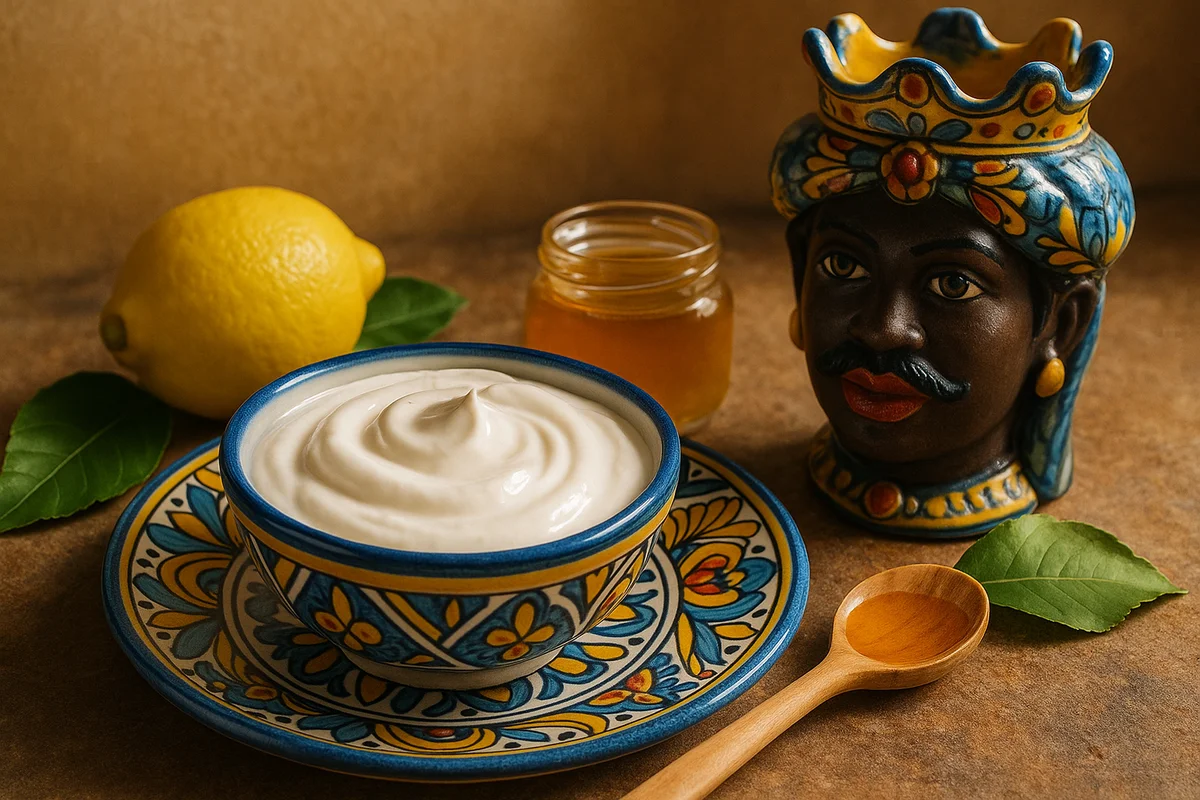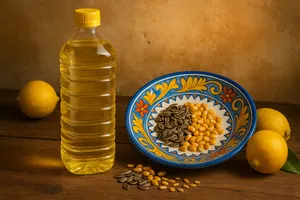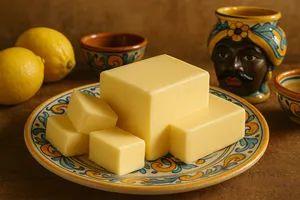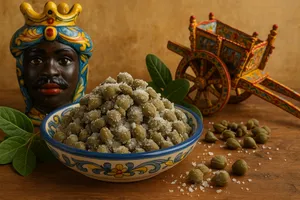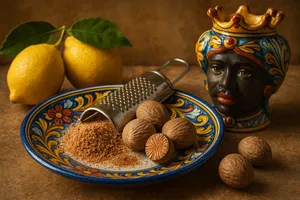Overview
Yogurt is a fermented dairy product obtained from the fermentation of milk (cow’s, goat’s, sheep’s or others) by specific lactic acid bacteria (mainly Lactobacillus bulgaricus and Streptococcus thermophilus). These bacteria convert lactose into lactic acid, giving yogurt its thick, creamy texture, characteristic tangy flavour, and probiotic qualities beneficial to gut health. Although yogurt is not part of Sicily’s historical culinary tradition (its widespread consumption in Italy dates largely from the post-war period), it has become a staple in modern Sicilian cuisine, used for breakfast, snacks, light desserts, sauces, condiments, and in preparations where acidity or moisture is desirable. Greek yogurt—denser, creamier, and richer in protein—is especially popular.
Yogurt represents modernity within tradition: it does not belong to Sicily’s rural dairy heritage (which relied on ricotta, tuma, and caciocavallo) but has been fully embraced in contemporary cooking thanks to its versatility, nutritional value, and lightness. For younger Sicilian generations, yogurt is as familiar as milk or cheese—synonymous with health, freshness, convenience, and balance. In today’s fusion-influenced Sicilian cuisine, yogurt often forms a bridge between the Mediterranean tradition and Middle Eastern flavours, where yogurt has millennia of history (Greek tzatziki, Lebanese labneh, Indian raita).
Characteristics
Yogurt has a creamy, smooth, dense consistency (varying by type: low-fat yogurt is more liquid; Greek yogurt is much thicker). Its colour is bright white or slightly creamy. The flavour is slightly tangy, fresh, and delicate (plain natural yogurt) or sweet (fruit or sweetened yogurt). The aroma is mildly lactic and acidic.
Texture and flavour depend on the type of milk used (whole, semi-skimmed, skimmed), the bacterial cultures, fermentation time and temperature, and any filtering (Greek yogurt is strained to remove whey).
Good-quality fresh yogurt has a smooth surface with only slight whey separation (a small amount is normal), a fresh, not overly acidic flavour, and no moulds or unusual odours.
Types of yogurt
Natural (plain) yogurt
Without added sugars, flavours, or additives. Tangy and versatile for both sweet and savoury recipes. The healthiest option.
Whole yogurt
Made with whole milk (around 3–4% fat). Creamier, fuller-flavoured, and more satisfying—ideal for cooking.
Low-fat or skimmed yogurt
Made with reduced-fat milk (0–1.5% fat). More liquid and lower in calories. Preferred for light diets.
Greek yogurt
Strained to remove whey, resulting in a very dense, velvety texture and high protein content (8–10g per 100g vs. 3–4g in regular yogurt). Less acidic. Excellent for cooking, sauces, and desserts.
Fruit yogurt
Yogurt with added fruit, sugar, flavourings. Sweet and pleasant but less healthy due to added sugars.
Probiotic yogurt
Contains added probiotic strains (L. acidophilus, Bifidobacterium, etc.) marketed for digestive health.
Kefir
A fermented milk drink similar to yogurt but more liquid, produced by bacteria + yeasts. More acidic and slightly effervescent. Very probiotic-rich.
Skyr
An Icelandic cultured dairy similar to Greek yogurt but even denser and higher in protein. Recently popular.
How yogurt is made
Industrial and homemade production follow similar steps:
1. Pasteurisation: Milk is heated to 85–90°C to remove unwanted bacteria and denature proteins (improves texture).
2. Cooling: Brought down to 40–45°C, optimal for yogurt cultures.
3. Inoculation: Lactic bacteria are added (or 2 tbsp of plain yogurt per litre in homemade versions).
4. Fermentation: Held at 40–45°C for 4–8 hours until thickened by lactic acid production.
5. Cooling: Refrigeration halts fermentation.
6. Straining (for Greek yogurt): Whey is removed through cloth or filters for a dense texture.
Homemade yogurt
Easy, economical, additive-free.
Ingredients: 1 litre whole milk, 2 tbsp plain yogurt with live cultures.
Method:
1. Heat milk to 85°C and hold for 5 minutes.
2. Cool to 40–45°C.
3. Mix a small amount of warm milk with the starter yogurt, then combine with the rest.
4. Pour into jars and incubate at 40–45°C for 4–8 hours (yogurt maker, warm oven, thermos, insulated pot).
5. Refrigerate for at least 4 hours. Keeps 7–10 days.
Use in contemporary Sicilian cuisine
Breakfast and snacks
Consumed plain or with honey, fresh fruit, granola, nuts, or jam. Nutritious and digestible.
Light desserts
Cheesecakes, mousses, semifreddi, and yogurt ice creams—creamy and fresh. Yogurt adds moisture and lightness.
Cakes and muffins
Adding yogurt to batter yields softer, moister cakes and muffins—ideal for healthy baking.
Sauces and dressings
Yogurt-based sauces with garlic, lemon, and mint accompany grilled vegetables, falafel, or fritters—lighter than mayonnaise. Greek yogurt is ideal.
Sicilian-style tzatziki
Greek yogurt, grated cucumber, garlic, oil, and mint/anise. A Mediterranean fusion dip for fried foods, fish, or grilled meats.
Meat marinades
Marinating chicken or lamb in yogurt with spices tenderises the meat and adds flavour.
Smoothies
Blended with fresh fruit, ice, and honey—refreshing and nutritious, especially in summer.
Frozen yogurt
Lighter alternative to traditional ice cream with tangy freshness.
Greek yogurt vs. regular yogurt
Greek yogurt:
- Strained, very dense and creamy
- Higher protein (8–10g/100g)
- Less acidic, milder flavour
- Holds up well in cooking and sauces
- More expensive
- Best for culinary use
Regular yogurt:
- Unstrained, thinner consistency
- Lower protein (3–4g/100g)
- More acidic
- May separate when heated
- More economical
- Ideal for everyday consumption
Storage
Yogurt should be stored in the refrigerator at 4°C. The expiration date indicates optimal quality but yogurt often remains safe a few days beyond if kept refrigerated and sealed. Check for absence of moulds or off smells.
Once opened, consume within 3–5 days. Use clean utensils to avoid contamination.
Yogurt can be frozen (for smoothies or cooking), but texture changes upon thawing.
Nutritional benefits
Whole yogurt provides 60–70 kcal per 100g; low-fat versions 40–50 kcal. It contains protein (3–4g in regular, 8–10g in Greek), carbohydrates (4–5g mostly from residual lactose), fats (3–4g whole, <1g skimmed), calcium, B vitamins, phosphorus, and potassium.
Live probiotic cultures support gut health, digestion, immunity, and recovery after antibiotic treatments. Yogurt is easier to digest than milk for many with mild lactose intolerance.
Satiating, hydrating, and nutrient-rich, yogurt is excellent for balanced diets and low-calorie regimens.
Yogurt around the world
Yogurt has ancient origins (over 5000 years) in Central Asia and the Middle East. It spread to Turkey, the Balkans, Greece, and India, where it became a staple. The word “yogurt” comes from Turkish yoğurt.
Greece: tzatziki; yogurt with honey and nuts.
Turkey: ayran; yogurt sauces for dolma.
India: raita; lassi.
Middle East: labneh.
Bulgaria: traditional yogurt with L. bulgaricus.
Curiosities
The word “yogurt” has multiple variants worldwide: “yoghurt”, “yaourt”, “jogurt”.
A legend credits its discovery to nomadic shepherds whose milk fermented naturally in animal skins.
Elie Metchnikoff, Nobel laureate (1908), linked the longevity of Bulgarian peasants to yogurt consumption, pioneering probiotic research.
The first commercial yogurt was sold in a pharmacy in Barcelona in 1919 by Isaac Carasso (Danone).
Greek yogurt is a method, not necessarily a geographical product; however, “authentic Greek yogurt” is protected for production in Greece.
The two yogurt bacteria work in symbiosis: one produces amino acids, the other formic acid—each supporting the other.
Frozen yogurt originated in the US in the 1970s and exploded in popularity in the 2000s.
Yogurt is one of the most studied foods for health effects, with thousands of scientific papers supporting its benefits.
A Turkish proverb says: “A yogurt soup cures a thousand ailments.”
Global yogurt production exceeds 60 million tonnes annually.
In space research, yogurt has been considered as a potential food for long missions due to its nutrients, probiotics, and theoretical producibility onboard.

